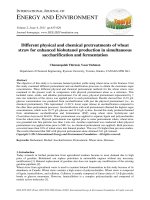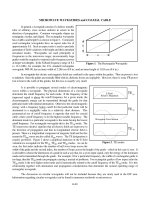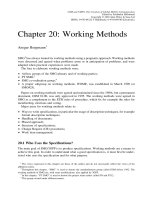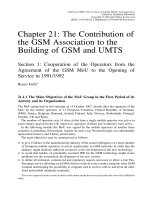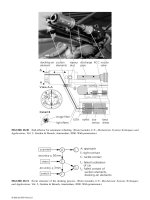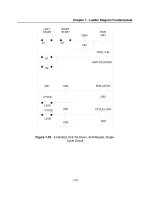Functional Groups and Chemical Families pptx
Bạn đang xem bản rút gọn của tài liệu. Xem và tải ngay bản đầy đủ của tài liệu tại đây (11.19 KB, 6 trang )
1
Functional Groups and Chemical Families
Although there are a wide variety of organic compounds, most of them are composed of the elements
from the upper right hand portion of the periodic chart: C, H, N, O, S, Halogen. These compounds
can be categorized by certain structural and reactive features, dictated by the way carbon bonds to
itself or another element, e.g. carbon double bonded to oxygen. Such a grouping of compounds
provides us with the concept of chemical families. These special bonding arrangements have different
reactivities or functions and associated with each family is particular functional group.
Rigorously speaking the functional group is not the whole molecule but only that collection of atoms
that provides a specific chemical function. For example, the chemical family of alcohols is
characterized by the function of the hydroxyl (OH) group, and aldehydes, ketones are characterized
by carbonyl groups (C=O). There are various combinations of hydroxyl groups in molecules along
with carbonyl groups and these combinations can lead to hydroxyketones and aldehydes (the basis for
sugars) as well as to carboxylic acids. Indeed, esters, and amides also have carbonyl groups (C=O)
but differ in their combination with an additional structural feature. To understand the reactivity of
chemical families one must consider the interplay between the various structural features in that
molecule, and identifying the fundamental functional groups is a good place to start.
Within a given family family members are arranged by the length of the longest carbon chain.
Typically an organic compound will have a base name composed of a suffix to identify the family and
a prefix to identify the length of the longest carbon chain. The first 10 prefixes are
meth- 1 hex- 6
eth- 2 hept- 7
prop- 3 oct- 8
but- 4 non- 9
pent- 5 dec- 10
The following provides a list of the more common chemical families exemplified as their pent-
member.
Hydrocarbons (all C,H)
Alk
anes
2
Molecular formula C
n
H
2n+2
C
5
H
12
pentane
Alk
enes
Molecular formula C
n
H
2n
C
5
H
10
pentene
Alk
ynes
Molecular formula C
n
H
2n-2
C
5
H
8
pentyne
Cyclo(-alk
anes,
-alk
enes
, -alk
ynes
)
C
10
H
16
cyclodec yne
cyclopent ene
cyclopent ane
C
5
H
8
C
5
H
10
Arenes
C
6
H
6
benzene
Heteroatom Substituted Hydrocarbons
3
Alkylhalides
(haloalkanes)
Br
pentyl bromide
C
5
H
11
Br
bromopent ane
This example uses bromine but any halogen (ie group VIIb) element applies: fluorine; chlorine;
bromine; iodine.
Alcoh
ols
OH
pentyl alcohol
C
5
H
12
O
pentanol
Ethers
O
pentyl ethyl ether
C
5
H
12
O
ethoxy pentane
Al
dehydes
O
H
valeraldehyde
C
5
H
10
O
pentanal
Ket
one
s
O
O
propan one
acetone
C
3
H
6
O
C
5
H
10
O
pentanone
Carboxylic Acids
4
O
OH
OH
O
ethanoic acid
acetic acid
C
2
H
4
O
2
C
5
H
10
O
2
pentanoic acid
Esters
O
OEt
OMe
O
ethyl ethanoate
ethyl acetate
C
4
H
8
O
2
C
6
H
12
O
2
methyl pentanoate
Thiols
SH
C
5
H
12
S
pentane thiol
Amines
NH
2
C
5
H
13
N
pentanamine
Nitriles
N
N
ethane nitrile
acetonitrile
C
2
H
3
N
C
5
H
9
N
pentane nitrile
5
Amides
O
NH
2
NH
2
O
pentanamide
C
5
H
11
NO
C
2
H
5
NO
ethanamide
acetamide
Using functional groups to predict reactivity.
Once having a list of common functional groups, the organization of those functional groups by
oxidation state is another useful way to see reactivity patterns. To simplify the method, look first to
the one carbon members of the oxahydrocarbon families (alkanes to carbon dioxide). Hydrogen and
oxygen are redox standards at +1 and –2, respectively. Thus, the carbon oxidation state in methane is
–4, in methanol it is –2, in formaldehyde (methanal) it is 0, in formic acid (methanoic acid) it is +2,
and in carbon dioxide it is +4. From these few examples, one sees that carbon is very versatile in the
oxidation states it can adopt. Crudely separating reactivity into redox and acid/base character, it
should be clear that the conversion of methane to methanol cannot proceed by simply by acid/base
reagents by requires redox character, specifically an oxidizing reagent. Once the oxidation state of
carbon is assigned for these functional groups it is possible to relate other functional groups to these
redox archetypes in order to form a sort of periodic table of the functional groups (Table).
Table. Periodic Table of the Functional Groups (Chemical Families).
Redox -> -4 -2 0 +2 +4
Elements Methane Methanol Formaldehyde Formic Acid Carbon
Dioxide
CHO Alkanes Alcohols
Ethers
Aldehydes
Ketones
Acids
Esters
Carbon
Dioxide
6
(Alkenes) Acetals
Ketals
(Alkynes)
Halide X Alkyl
Halides
Gem-dihalides Gem-
trihalides
Acid Halides
Carbon
tetrachloride
Nitrogen Amines
Nitriles**
Azides
Imines Amides
Imidines
Nitriles**
Carbo-
dimides
Sulfur Thiols
Mercaptan
s
Thioketones
Thio ketals
Thio esters Carbon
disulfide
Phosphoro
us
Phosphine
s
From this table of the functional groups one recognizes that any transformation between columns
must involve a redox process whereas transformations between rows can be accomplished by
acid/base processes. It forms a scaffolding on to which we can hang our knowledge of reactivity, and
at the same time it prepares us to think of yet unseen transformations on the basis of how those
transformations might be effected. This abstraction of chemical structure into a focused relationship
of functional group types can be one the most powerful tools for understanding and simplifying
organic chemical reactivity.
